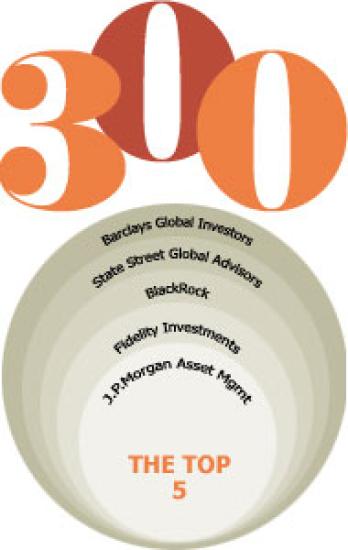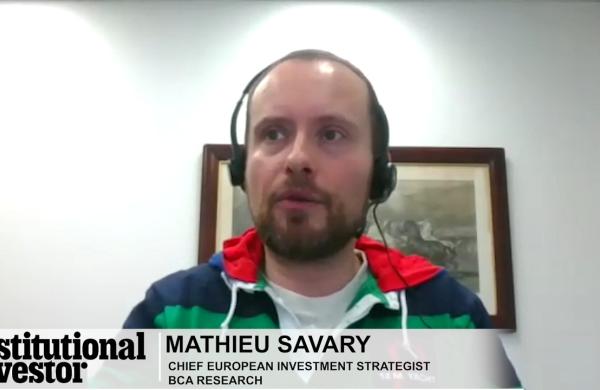Questions about the future of the asset management industry abound. The credit crisis that started brewing two years ago triggered a stock market meltdown in 2008 that humbled even the best of the U.S.’s 300 largest money managers, shaving 38.5 percent off the Standard & Poor’s 500 index.
Even this elite group, the II300, which Institutional Investor ranks every year, saw its total assets tumble by 23.4 percent last year, to $26.7 trillion. The hardest hit asset classes were the riskiest — equity, which fell 41.3 percent, and alternatives, which fell 26.1 percent. Bonds, normally the darling of investors when stocks are in a tailspin, also fell, by 9.3 percent. The only asset class that actually grew last year was cash equivalents — and even then by only 3.9 percent, to $5.47 trillion.
[Click here to view complete results of the 2009 America's Top 300 Money Managers.]
The industry’s misery speaks to recent trends that are now sapping firms of revenue as wary investors plow money into asset classes that incur the lowest risks and charge the lowest fees. Investors have gravitated toward firms that are large enough to offer a full spectrum of strategies packaged as solutions, which is likely to encourage consolidation in the industry.
That’s the conclusion of a recent survey of more than 100 big money management firms by McKinsey & Co., the New York–based management consulting firm, in conjunction with the U.S. Institute, a private membership group organized by a unit of II that brings together senior officials from leading U.S. investment firms. The money managers that were fortunate enough to recognize and anticipate secular, structural change from the outset of the recession last year were quick to take painful cost-cutting measures to prepare for a lower-revenue environment and rethink how they sell investment products to pension funds. But other firms simply missed what turned out to be a narrow window within which to react effectively and didn’t realize until this year that they had better start trimming expenses.
“The industry woke up, but it woke up late,” says David Hunt, a senior partner at McKinsey. “Many managers are hoping the market will bail them out. I think they will discover that is not going to happen and that 2009 will be a tougher year than 2008 was for the asset management industry.”
It’s hard to imagine how any year could be worse for money managers than 2008, but the McKinsey-II study shows that it is a distinct possibility if the recession is prolonged. The survey of asset managers found that, on average, their revenue after costs fell by 5.0 percent last year, to 39 basis points per dollar of assets under management in institutional accounts. In retail mutual funds, net revenue after costs fell 7.0 percent, to 43 basis points. This decline in net revenue yield is already cutting into profits, as the firms’ average operating profit margin fell 3 percentage points last year from 33 percent in 2007.
The overall composition of assets shifted last year as investors reacted to the global market crash by dumping active equity, hedge funds and private equity — which earn the highest fees in the industry — and grabbing the cheapest products on the shelf, such as index funds and money market funds. Pension funds in particular moved into liability-driven investment, or LDI, a fixed-income strategy that is designed to limit volatility over the long term, says Hunt.
Although investors have not abandoned active strategies altogether, they are increasingly demanding that their managers offer a full spectrum of investment strategies, provided in a comprehensive package, as solutions for a volatile environment. Instead of just picking products off the shelf — which gives a manager an opportunity to sell its wares separately and at higher fees than as a basket of combined products — pension funds and other institutional clients are now sitting down with their money managers and asking for advice on how to assemble the package, says Andy Maguire, a senior partner at Boston Consulting Group in London.
This method of doing business can be expensive for money managers. It favors firms with the most diverse selection of investment capabilities, a global footprint and the sheer scale required to operate at narrower profit margins in an environment where revenue is hard to come by.
It also encourages consolidation. “I do expect that there will be a lot of M&A activity,” says Robert Lee, an analyst at Keefe, Bruyette & Woods in New York who covers asset managers.
On the retail side, revenue is getting pinched by an additional wave of consolidation — this one of firms that are technically outside the asset management industry. The five biggest broker-dealers and financial advisers, the largest of which was created by the recent merger of Morgan Stanley and Smith Barney, now control 61 percent of household assets, a 20 percentage point increase over the past five years, according to the McKinsey-II survey.
“It’s bad for money managers because they will be squeezed increasingly by powerful distributors,” says Hunt. “The money managers’ revenue will go down.”
One firm that has benefited from the shift in overall composition of assets is Barclays Global Investors, which finishes first in the II300 for a fifth straight year, with $1.53 trillion in assets as of December 31, 2008. Although the San Francisco–based quant shop, which uses computer programs instead of analysts to select securities, lost 26.4 percent of its total assets last year, it did grow one asset class — domestic U.S. bonds, which rose by 27.6 percent, to $176.25 billion, as investors deposited money in its passive index funds.
“Institutional indexing is obviously a very mature business, and yet I can tell you that we continue to see very robust asset flows in those areas,” says Blake Grossman, CEO of BGI.
Another money manager that has seen gains from the transition to low-risk strategies is New York-based Bank of New York Mellon Corp., which jumps to No. 8 from No. 10; its cash equivalents under management grew by 31.4 percent, to $386.02 billion, last year. “What started as a flight to quality turned into a flight to cash,” says Ronald O’Hanley, president and CEO of BNY Mellon Asset Management, the money management unit of Bank of New York Mellon. Overall, the bank performed relatively admirably, as its total assets fell by 14.6 percent, to $847.53 billion.
Then there is BlackRock, which was barely bruised last year. The New York–based institutional quant shop jumps to No. 3 from No. 5, even though its assets remained nearly flat, at $1.31 trillion. The firm was early to recognize the secular impact of the market meltdown, eliminating 500 jobs, or 9 percent of its workforce, last year, says COO Susan Wagner. It also anticipated the demand from clients for managers that can provide a full range of strategies in a single package.
That, of course, was the rationale behind BlackRock’s $13.5 billion acquisition of BGI, which BlackRock announced in June and plans to complete in the fourth quarter of this year.
“There’s a big change in the way investors want to build solutions that help them meet their investment needs, and those are going to be more global in nature, cross asset classes and involve more of an asset-allocation and advisory component,” says Wagner.
On a smaller scale, one outfit that anticipated the fundamental change was T. Rowe Price Group, which lost 30.9 percent of its assets in 2008, finishing the year at No. 24, down from No. 22. “We started feeling a little squeamish about the market from late 2007,” says Edward Bernard, the Baltimore-based mutual fund firm’s vice chairman in charge of marketing and distribution. “We started avoiding expenses well before others — on January 2, 2008, literally from day one.”
Some firms were simply too slow in reacting. One was Capital Group Cos., which was No. 3 last year; it lost 37.9 percent of its assets in 2008 and falls to No. 6, with $962.03 billion under management. “Almost to a person, we admit that we did not foresee the magnitude or breadth or depth of what ensued,” admits Dale Hanks, a vice president of Los Angeles–based Capital Research and Management Co., which runs the American Funds.
The jury is out on when the industry will recover. The McKinsey-II survey indicates that it could take anywhere from four to seven years to reach the $34.87 trillion that the II300 oversaw on December 31, 2007. To regain those assets, managers will have to find new ways of investing for their clients. “Going back to ‘same old, same old’ is just not going to cut it,” says BCG’s Maguire.






